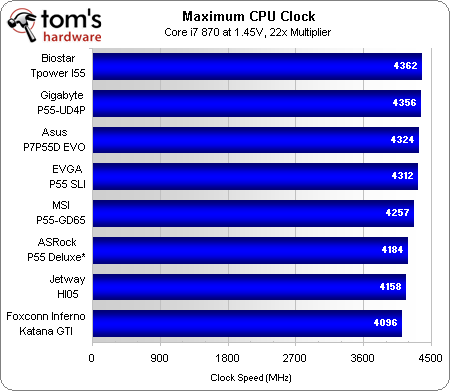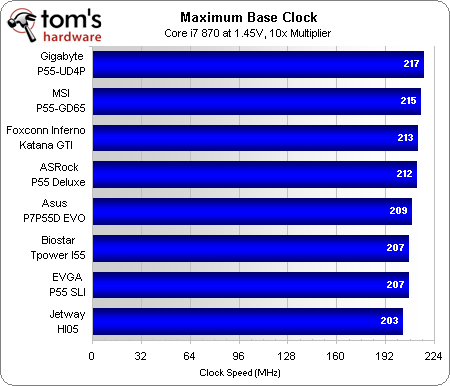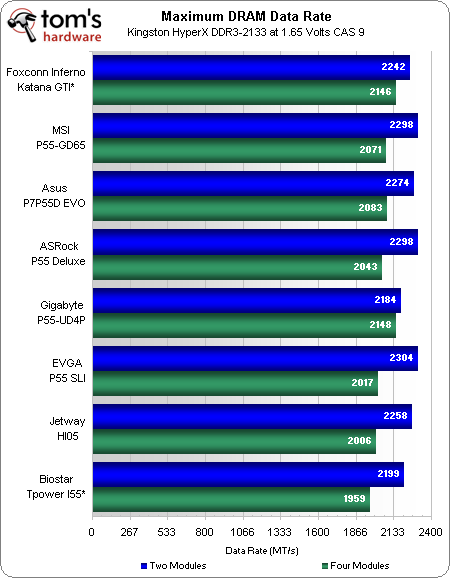Enthusiast P55: Eight LGA 1156 Boards Between $150 And $200
Overclocking
Every product in today’s comparison provides wide enough frequency and timing selections to push our big air cooler to the limit, even with an ambient temperature below 22 degrees Celsius.
| BIOS Frequency and Voltage settings (for overclocking) | ||||
|---|---|---|---|---|
| ASRock P55 Deluxe | Asus P7P55D EVO | Biostar TPower I55 | EVGA P55 SLI | |
| CPU Base Clock | 100-300 MHz (1 MHz) | 80-500 MHz (1 MHz) | 100-800 MHz (1 MHz) | 133-600 MHz (1 MHz) |
| CPU Multiplier | Yes | Yes | Yes | Yes |
| DRAM Data Rates | BCLK x6 - x12 (x2) | BCLK x6 - x12 (x2) | BCLK x6 - x12 (x2) | BCLK x6 - x12 (x2) |
| PCIe Clock | 50-150 MHz (1 MHz) | 100-200 MHz (1 MHz) | 100-150 MHz (1 MHz) | 100-200 MHz (1 MHz) |
| CPU Vcore | 0.84-2.00V (6.25mV) | 1.10-1.70V (6.25mV) | +7875mV (6.25mV) | +630mV (10mV) |
| Uncore Voltage | 1.11-2.04V (14.5mV) | 1.10-1.70V (6.25mV) | 1.10-2.03V (15mV) | +630mV (10mV) |
| PCH Core | 1.07-1.49V (6.5mV) | 1.05V, 1.15V | 1.10-2.03V (15mV) | +300mV (10mV) |
| DRAM Voltage | 1.56-2.01V (14mV) | 1.20-2.50V (12.5mV) | 1.60-2.53V (15mV) | +630mV (10mV) |
| CAS Latency | 6-11 Cycles | 3-11 Cycles | 3-15 Cycles | 3-15 Cycles |
| tRCD | 3-15 Cycles | 3-15 Cycles | 3-15 Cycles | 3-15 Cycles |
| tRP | 3-15 Cycles | 3-15 Cycles | 3-15 Cycles | 3-15 Cycles |
| tRAS | 9-31 Cycles | 3-31 Cycles | 9-63 Cycles | 9-63 Cycles |
| BIOS Frequency and Voltage settings (for overclocking) | ||||
|---|---|---|---|---|
| Foxconn Inferno Katana GTI | Jetway HI05 | Gigabyte P55-UD4P | MSI P55-GD65 | |
| CPU Base Clock | 66-255 MHz (1 MHz) | 133-500 MHz (1 MHz) | 100-1200 MHz (1 MHz) | 100-600 MHz (1 MHz) |
| CPU Multiplier | Yes | Yes | Yes | Yes |
| DRAM Data Rates | BCLK x6 - x12 (x2) | BCLK x6 - x12 (x2) | BCLK x6 - x12 (x2) | BCLK x6 - x12 (x2) |
| PCIe Clock | 100-120 MHz (1 MHz) | 100-200 MHz (1 MHz) | 90-150 MHz (1 MHz) | 90-190 MHz (1 MHz) |
| CPU Vcore | -0.40-+1.26V (10mV) | -0.88-+8.00V (25mV) | 0.50-1.90V (6.25mV) | 0.87-2.70 (6.25mV) |
| Uncore Voltage | 0.95-1.50V (10mV) | 1.12-2.23V (17.5mV) | 1.05-1.99V (20mV) | 0.45-2.02V (5.38mV) |
| PCH Core | 0.95-1.50V (10mV) | 1.08-2.14V (17mV) | 0.95-2.00V (20mV) | 1.00-2.40V (10mV) |
| DRAM Voltage | 1.40-2.71V (10mV) | 1.54-3.26V (25.5mV) | 1.30-2.60V (20mV) | 0.91-2.40V (6.25mV) |
| CAS Latency | 3-15 Cycles | 3-15 Cycles | 6-15 Cycles | 4-15 Cycles |
| tRCD | 3-15 Cycles | 3-15 Cycles | 1-15 Cycles | 3-15 Cycles |
| tRP | 3-15 Cycles | 3-15 Cycles | 1-15 Cycles | 3-15 Cycles |
| tRAS | 9-63 Cycles | 9-63 Cycles | 1-31 Cycles | 9-31 Cycles |
However, not every setting is completely useful. Surely, most overclockers understand that base clock limits beyond 300 MHz are completely meaningless with the LGA 1156 platform, and not every board could fully support even our moderate 1.45V CPU core setting.
Biostar has put a lot of effort into its overclocking campaign, and that has paid off with a CPU overclocking win. Also notice the asterisk next to ASRock’s entry--this particular model wasn’t stable at 1.45V CPU core when maximum overclocks and eight Prime95 threads were applied. We found the highest practical setting for the P55 Deluxe was 1.40V, as anything higher would cause the motherboard’s over-current protection to reset the system under full load. We’re sure someone will try to prove us wrong by testing higher voltage levels with lower loads or clock speeds, but the only practical way we know to honestly increase the board’s amperage capacity is to increase VRM cooling.
Gigabyte takes a big lead over rival Asus and overclock-leader Biostar for maximum base clock, a setting that should be extremely important to multiplier-limited Core i5 owners.
Foxconn has the highest average memory overclock, while EVGA leads with two modules and Gigabyte leads when four are installed.
Get Tom's Hardware's best news and in-depth reviews, straight to your inbox.
Current page: Overclocking
Prev Page Benchmark Results: Synthetic Next Page Power, Heat, And Efficiency-
skora There's two market segments. Once you get the features you need, there's overclockers, and stock users. I've never seen a mobo recommended based on its application performance and all thats looked at is how well it OCs. Hopefully, people read the article and don't just go buying biostar expecting the regular quality of gigabyte or asus though the asus is a little overpriced here for my taste. That $25 can go towards a better GPU, but I'm a gamer.Reply -
Crashman enzo matrixinterestingReply
Gigabyte had some additional interesting news about the new P55A-UD4P, where the addition of the letter "A" supposedly means "Advanced" and refers to the addition of SATA 6.0 Gb/s and USB 3.0 controllers. Unfortunately, it wasn't ready when the comparison was written. The "A" also cost slightly more. -
ibnsina For $15 more is best to go for the newly released Giga-byte GA-P55A-UD4P, the extra’s you get are:-Reply
2 x USB 3.0
2 x SATA 6Gb/s.
$184.99 on newegg. -
Crashman ibnsinaFor $15 more is best to go for the newly released Giga-byte GA-P55A-UD4P, the extra’s you get are:-2 x USB 3.0 2 x SATA 6Gb/s.$184.99 on newegg.Reply
$15 for all that sounds great, unless those features are useless to you. SATA 6.0 Gb/s will remain completely useless until long after the board is outdated, and USB 3.0 is nothing more than an eSATA substitute at the moment. -
apache_lives Why do we bitch about IDE and FDD connectors? If your using windows xp and IDE hdd/dvd drives your should be ashamed, and even then you can get USB floppys etc, and if you are using those fittings you are not getting the true performance out of your modern system, and IDE also makes boot times longer thanks to detection and legacy delays - cudos to those who ditch those ports in an effort to modernise modern systems, and to those who keep them - its like adding ISA ports to the board - times up.Reply -
cahl The new P55A-UD4P has better power phasing, 12+2 vs 8+2 on the old gigabyte UD4P, and probably more stuff aswell, like the LOTES socket, well worth the extra $15 to me.Reply -
bigballinggpr You don't bring up MSI's board at all in the conclusion. . . i'm a little curious as to what your final thoughts are on it.Reply -
Crashman apache_livesWhy do we bitch about IDE and FDD connectors? If your using windows xp and IDE hdd/dvd drives your should be ashamed, and even then you can get USB floppys etc, and if you are using those fittings you are not getting the true performance out of your modern system, and IDE also makes boot times longer thanks to detection and legacy delays - cudos to those who ditch those ports in an effort to modernise modern systems, and to those who keep them - its like adding ISA ports to the board - times up.Reply
You mean complain? Like you're complaining right now? It's all a matter of logic: There are probably more Windows XP users carrying over their old OS into a new build than there are Ultra ATA users carrying over their ancient hard drives. Therefor, the floppy interface, as outdated as it is, is more useful than the Ultra ATA interface.
The problem as described is that you PAY for an Ultra ATA controller. Why bother? Even if you're an XP devotee you probably don't WANT to pay for an Ultra ATA connector.
But for most motherboards, the floppy interface is free. It doesn't slow down boot times or performance either, if you don't need it you can ignore it.
Well, maybe you can't ignore it, but a logic dictates over emotion in reviews.
THG has no reason to love or hate the floppy connector, no stake in the legacy OS game, but anyone reader who wants to play the hater deserves to be called out for it. As for the manufacturers, honest reporting is Tom's Hardware's goal. Personally, I like the fact that some manufacturers provide legacy features and others don't, both types of products work well. -
doomtomb Replywith only a single PS/2 port left behind to support the older mice occasionally preferred by seasoned gamers
This is from the page on the EVGA P55 but you can clearly see it is a purple PS/2 port which is for keyboards... lol



